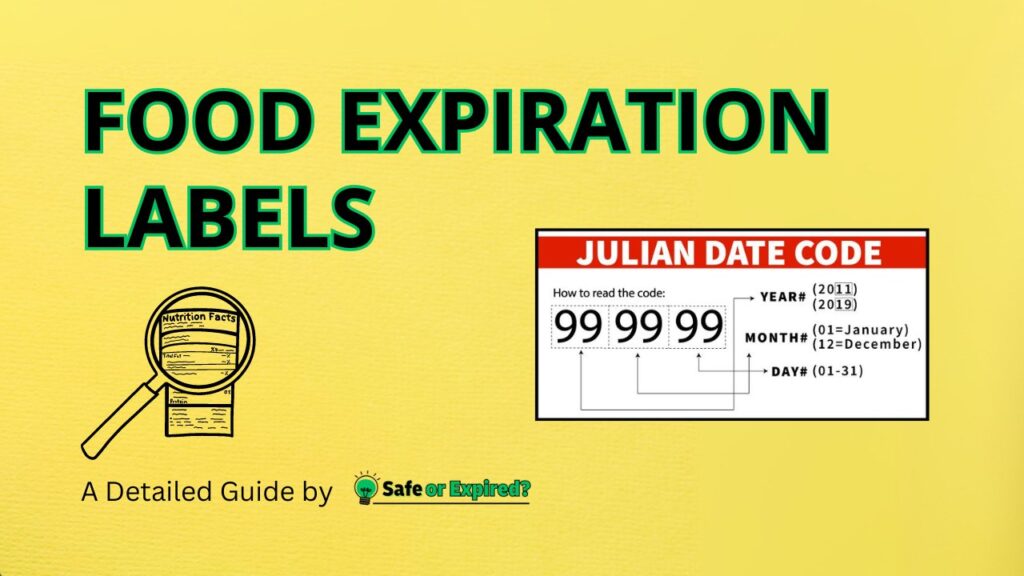Understanding food expiration labels is super important for everyone. It’s not just about not getting sick – it’s about saving money, eating healthier, and reducing waste, too! Whether you’re a busy parent or a college student, knowing how to read these labels can change the way you shop and eat. Stick with us to uncover easy tips that can make a big difference in your daily life!
How to Read Expiration Dates? Decoding 8 Formats
Understanding expiration dates on food labels is essential for maintaining food safety and quality. The “MMDDYY” format, common in the U.S., indicates month, day, and year, respectively, showing the optimal consumption date. Reading these correctly helps consumers determine freshness and avoid waste.
MMDDYY (Standard US Format)
The MMDDYY format is a standard dating method used in the United States to indicate the month, day, and last two digits of the year, typically in that order. For example, a label reading “041523” translates to April 15, 2023. This format is primarily used to inform consumers of the peak quality date of a product, though it is not necessarily a safety indicator.
Here’s another example. If a package of fresh pasta has a label stating “092223,” it means the pasta is best consumed by September 22, 2023.
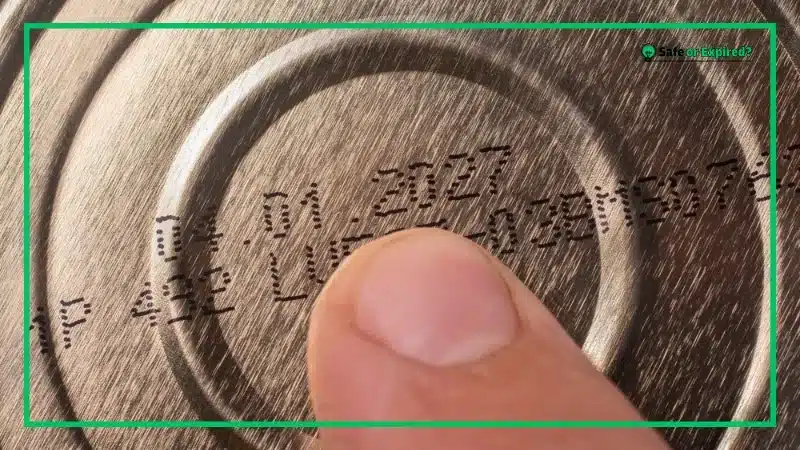
In some cases, manufacturers may separate the elements with slashes for clarity, such as “09/22/23.” This format is straightforward and familiar to most U.S. consumers, making it easy to understand at a glance. Consumers should note that while some products may still be safe to consume after the date, the quality might not be as good.
DDMMYY (Standard European Format)
The DDMMYY format, widely used in Europe, lists the day, month, and year in that order. It serves a similar purpose to the U.S. format, helping consumers identify the best period for product usage based on quality standards set by manufacturers.
Example: An almond milk carton labeled “230423” should ideally be consumed by April 23, 2024.
Dates are often separated by dots or slashes like “23.04.24” or “23/04/24” for clarity. This format is crucial for consumers in Europe to understand as it ensures they are consuming products within the optimal freshness period.
MMMDDYY (Month Abbreviated)
The MMMDDYY format uses an abbreviation for the month followed by the day and the last two digits of the year. This method offers clearer readability and is less prone to misunderstanding due to the use of the abbreviated month name.
Example: A yogurt container marked “JAN1524” indicates that the product is best before January 15, 2024.
This format can vary slightly with the month positioned at the beginning or the end, but it generally remains within the month-day-year sequence. Labels might use a space or hyphen for separation, like “JAN-15-24” or “JAN 15 24.”
This date format helps avoid the numerical confusion that can occur with other systems, particularly for international consumers unfamiliar with other dating methods.
DDMMM (Day and Month Abbreviated)
The DDMMM format is commonly used for items with a relatively short shelf life and includes the day followed by an abbreviated month, with no year included. This format is particularly useful for indicating the freshness of perishable goods.
Example: “15 NOV” on a package of deli meat suggests it should ideally be consumed by November 15th of the current year.
The absence of the year in this format implies that the product is not intended for long-term storage and should be used within a short timeframe, often within the current year. This format is straightforward and helps reduce the clutter on labels, making it quick and easy for shoppers to determine the freshness of their purchases.
Proper storage can extend the life of your food beyond the dates on the label. For practical tips, read “Effective Techniques for Food Storage and Preservation.”
MMMYYYY (Month and Year)
The MMMYYYY format consists of the abbreviated month followed by the full four-digit year. This format is particularly useful for products with a longer shelf life, where the exact day is less critical to the product’s usability.
Example: A container of pancake mix might be labeled “DEC2024,” indicating that it is best used before December 2024.
This format is highly intuitive and easy to read, reducing confusion about expiration dates. By focusing on the month and year, it simplifies stock management for both retailers and consumers.
YYMMDD (Less Used)
The YYYYMMDD format is an internationally recognized date sequence that starts with the year, followed by the month, and ends with the day. Here’s an example: A product labeled “20240523” indicates that it is best used before May 23, 2024.
This format is often used in contexts requiring meticulous records, such as international shipping, medical supplies, and legal documents, due to its clarity and universality.
Also, listing the year first provides an immediate sense of the item’s age, which is particularly useful for inventory management and long-term storage.
Julian Date (3, 4, or 5 Digits)
Julian dates are a continuous count of days since the beginning of the Julian Period used primarily by food manufacturers for internal tracking. This code is crucial for ensuring freshness, especially in products like dairy and canned goods.
Example: “215” would represent the 215th day of the year, or August 3. If the code is “2215,” it indicates the year 2022 and the 215th day (August 3, 2022).
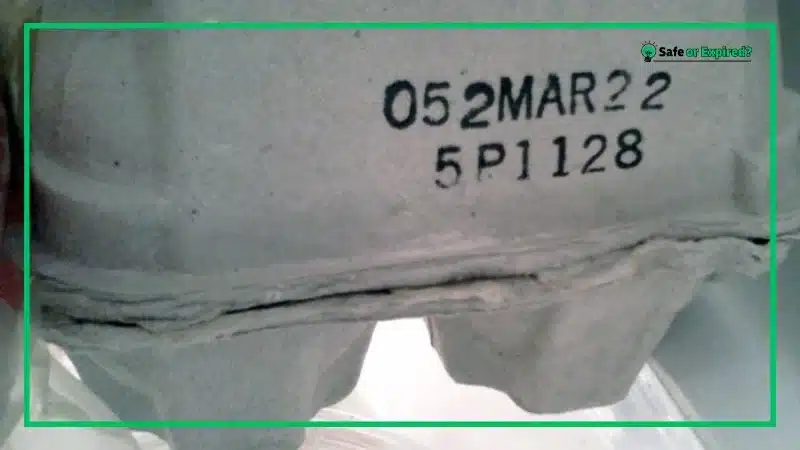
Consumers can use the Julian date to determine the exact day of manufacture, which is especially useful for items like eggs, where freshness directly impacts quality. However, understanding Julian’s dates may require some conversion, usually through online tools or charts.
Please refer to this helpful Julian Calendar for a more detailed insight.
A-L Letter and 2 Digits
This format is used mainly for internal tracking purposes by manufacturers, not typically aimed at consumer communication. It involves using a letter (A to L) to represent the month (A for January, L for December) and a two-digit number for the day.
Example: “A15” would indicate January 15, while “L23” represents December 23.
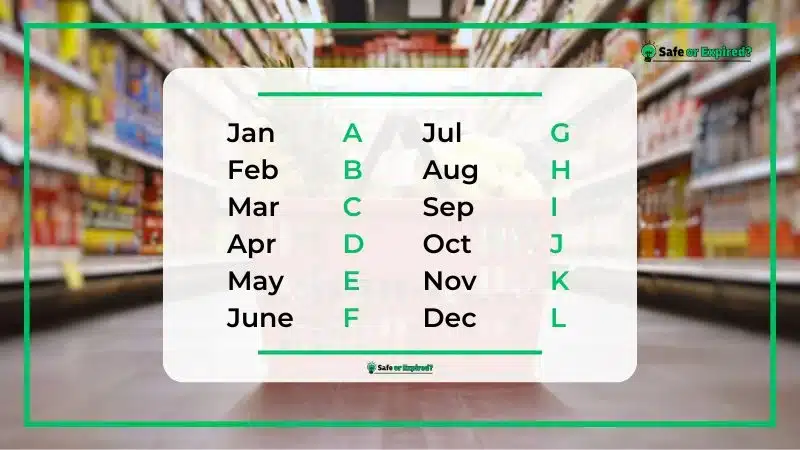
While not common in consumer products, understanding this format can be useful for those in the food service industry or those dealing with large-scale food supplies. It allows for precise tracking of production dates, helping manage inventory and ensure rotation of stock based on age.
Understanding Key Expiration Terms: A Guide to 5 Common Labels
Understanding food expiration labels is crucial for safety and quality. “Best Before” indicates peak quality, not safety. “Use-By” marks safety and quality thresholds. “Sell-By” helps retailers manage stock, still safe afterwards. “Freeze-By” suggests optimal freezing for quality. Moreover, the “Expiration Date” is a strict safety marker.
Below is a comparison table detailing the different expiration terms used on food labels:
| Term | Purpose | Typical Uses | Safety vs. Quality |
| Best Before | Indicates peak quality duration, not safety. | Snacks, dry goods, condiments. | Quality may decline after date; generally safe to consume. |
| Use-By | Last date for peak quality, with safety implications. | Perishable foods: meats, dairy, seafood. | Critical for safety; avoid consuming after this date. |
| Sell-By | Guides retailers on product sale duration. | Meat, dairy, bread. | Mainly for stock management; often safe to consume afterwards. |
| Freeze-By | Suggests optimal freezing time to maintain quality. | Fresh meats, seafood, dough products. | Quality-focused; extends consumable life via freezing. |
| Expiration Date | Marks the last safe consumption day. | Baby foods, some canned goods, perishable condiments. | Strictly safety-related; consuming past this date is risky. |
Best Before (or Best if Used By)
The “Best Before” or “Best if Used By” date advises consumers on when a product is likely to start losing its peak quality but does not necessarily become unsafe to consume. This label is based on the manufacturer’s detailed analysis of the product’s optimal freshness and taste duration under typical storage conditions.
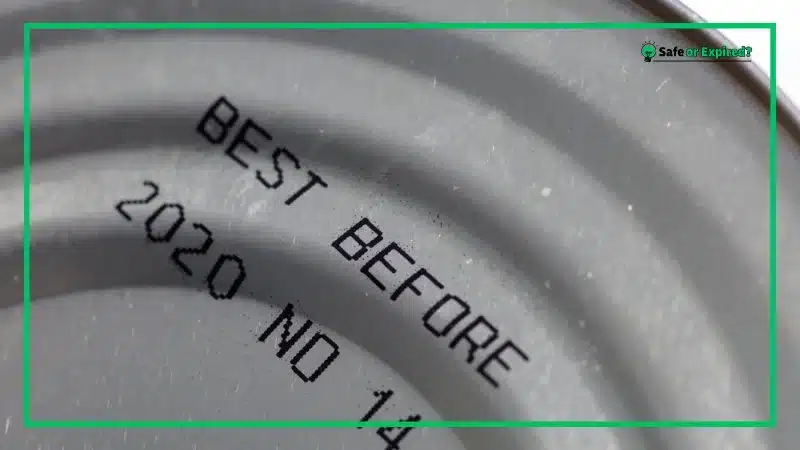
Common Foods Using This Format are:
- Dry and Canned Goods: These include cereals, pasta, rice, canned vegetables, and canned fruits. These products don’t spoil quickly but may lose some texture or flavor after the date.
- Snacks: Chips, popcorn, and crackers are usually safe to eat after the “Best Before” date but might not taste as fresh.
- Frozen Foods: Items like frozen vegetables, fruits, and ready-to-eat meals carry a “Best Before” date indicating when they might begin to suffer from freezer burn or lose flavor, though they remain safe to consume.
- Confectionery: Chocolate and candies are often marked with a “Best Before” date; they remain safe to eat but may experience changes in taste or texture.
Understanding and adhering to “Best Before” dates can significantly reduce food waste. Consumers throwing away products just because the “Best Before” date has passed contributes to unnecessary waste, as these items are often still perfectly consumable.
Use-By
The “Use-By” date is a safety indicator, particularly critical for perishable goods where consuming the product past this date could pose health risks due to the natural deterioration of ingredients and potential for bacterial growth.
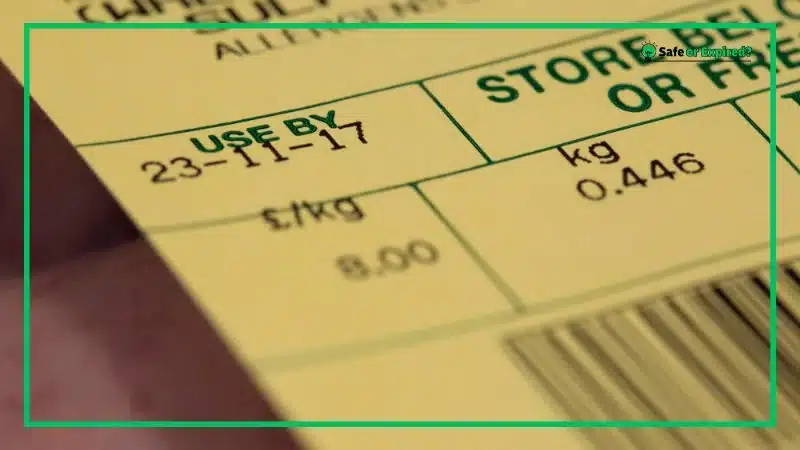
Common Foods Using This Format are:
- Meat and Poultry: Fresh chicken, beef, and pork often have “Use-By” dates, after which there is a risk of bacterial growth if the products are not cooked or handled correctly.
- Dairy Products: Milk, cheese, and yogurt carry “Use-By” labels to ensure consumption while they are safe and of the best quality, avoiding the risk of foodborne illnesses.
- Seafood: Fresh fish and shellfish need to be consumed by the “Use-By” date to prevent issues such as food poisoning from bacteria.
- Prepared Salads and Sandwiches: These items are highly perishable and usually carry a “Use-By” date to ensure they are eaten while fresh and safe.
- Baby Formula: This is a critical product that must adhere strictly to its “Use-By” date due to nutritional degradation and safety concerns for infants.
Note that adherence to food safety guidelines and storage instructions (e.g., refrigeration) is crucial for products with “Use By” dates. Improper storage can accelerate the deterioration process, making even a “Use By” date unreliable.
“Use By” dates are also strictly regulated in many regions to ensure public health safety. Businesses must meticulously test and verify these dates to comply with local and international food safety standards.
Knowing how food safety authorities work to protect us can add another layer of confidence when you shop and eat. Find out how in “How Food Safety Authorities Safeguard Our Food.”
Sell-By
The “Sell-By” date is a label used primarily by retailers to manage their stock, indicating the last day a product should be displayed for sale. This date helps stores ensure that customers buy products at their best quality. It is not a safety date for consumers, but rather a guideline to the retailer for product rotation.
Proper understanding of “Sell-By” dates assists retailers in managing inventory efficiently, reducing waste while ensuring the rotation of fresh goods.
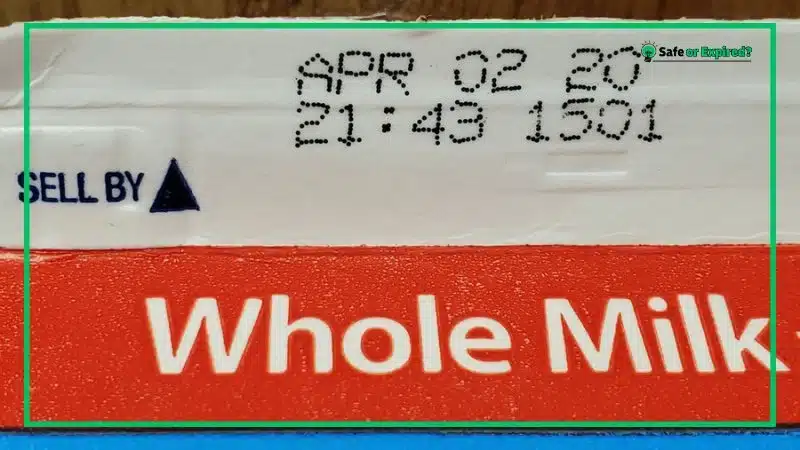
Common Foods Using This Format:
- Dairy Products: Items like milk and yogurt often have “Sell-By” dates to guide stores on how long they can keep the product on shelves before it begins to decline in quality.
- Fresh Meat and Poultry: These are typically sold with a “Sell-By” date that tells the store until when the product can stay on sale. This date helps ensure that the meat is still fresh when purchased and has enough shelf life left for safe consumption.
- Bread and Baked Goods: Bakeries use “Sell-By” dates to indicate how long products can remain on sale before they start to stale.
While the “Sell-By” date is meant for retailers, consumers can use it as a rough guide to gauge the freshness of a product. It is generally safe to consume a product after the “Sell-By” date, but its freshness might not be guaranteed.
Freeze-By
The “Freeze-By” date is a less commonly used label advising consumers on when to freeze a product to maintain its optimal quality. Freezing a product by this date helps preserve its taste, nutritional value, and quality before a noticeable decline occurs.
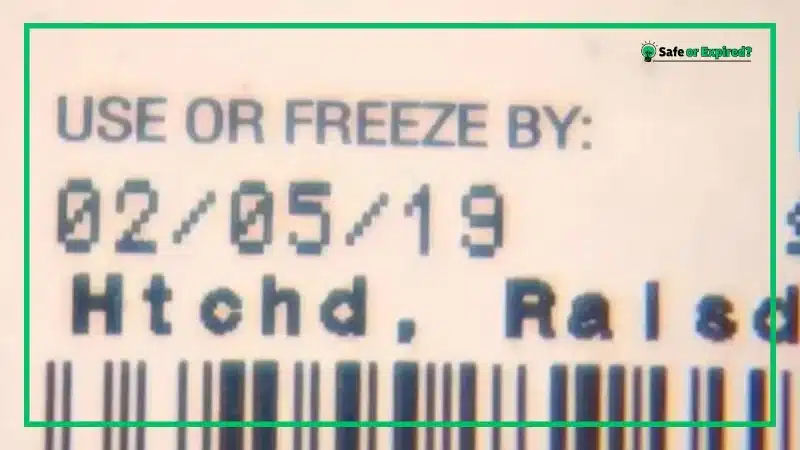
Common Foods Using This Format:
- Fresh Meat and Seafood: These products may carry a “Freeze-By” date to suggest when it’s best to freeze them if you are not planning to use them immediately.
- Bread and Dough Products: These can also have a “Freeze-By” date, as freezing them extends their usable life beyond what would be expected if kept at room temperature.
Following the “Freeze-By” date ensures that the product remains as close to its fresh state as possible. Freezing can effectively pause the aging or degradation process, making this date crucial for maintaining quality.
Remember that freezing products by this date is particularly useful for consumers looking to buy in bulk and store food long-term without sacrificing quality.
Expiration Date (or EXP)
The “Expiration Date” (EXP) label is the most definitive among date markings on food products. This date indicates when a product should no longer be consumed due to potential health risks or a significant decline in quality. Unlike “Best Before” and “Use-By” dates that indicate peak quality, the expiration date is concerned primarily with safety.
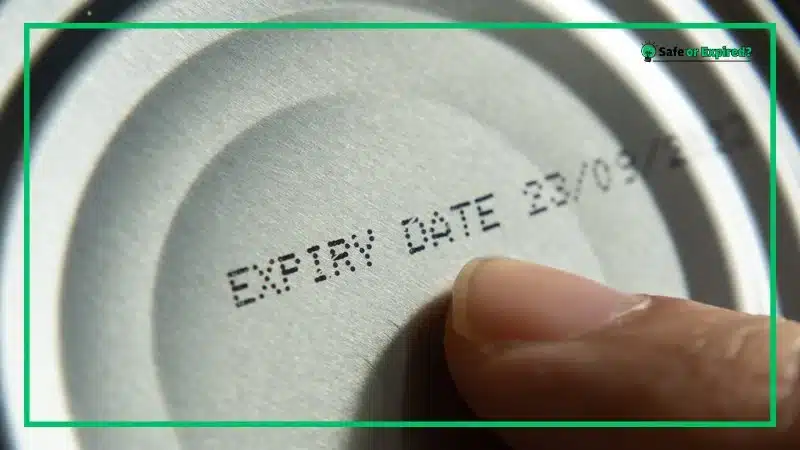
Common Foods Using This Format:
- Baby Formula and Baby Foods: These products are critical to infant health and nutrition, making the expiration date especially important. Consuming these products after the expiration date can lead to nutritional deficiencies or health risks for babies.
- Pharmaceuticals and Vitamins: While not food, these products often carry an expiration date to indicate when they may no longer be effective or safe to use.
- Canned Goods: Some canned products may also feature an expiration date, beyond which the food might not be safe to eat.
- Perishable Condiments: Certain condiments that can spoil, such as salad dressings or mayonnaise, also carry expiration dates to ensure they are used when safe and effective.
It’s also vital to recognize when food is no longer safe to eat, despite what the label might say. Learn the signs to watch for in “Recognizing 9 Signs of Food Spoilage.”
It is advised to always adhere to the expiration date for products that include one, as this date is the manufacturer’s guarantee that the product will remain safe to use up until then.
Moreover, the accuracy of an expiration date can be affected by how the product is stored. Products need to be stored according to manufacturer recommendations to ensure they last until the expiration date without becoming unsafe.
So, now you know while learning about expiration labels, it’s essential to grasp the specific meanings of ‘expiration’ and ‘best by’ dates. To learn more about it, read the article “Understanding the Difference Between Expiration and Best By Dates.”
Why Is Understanding Food Expiration Labels Important For Everyone?
Understanding food expiration labels is essential for everyone as it helps ensure food safety, reduces waste, and saves money. Knowing what each label means can protect your health and help you make better decisions at the grocery store.
Reduces Food Waste
When you understand food expiration labels, you can avoid throwing away food that is still good to eat. For example, a “Best Before” date tells you when food might start to lose its best flavor or texture, but it’s usually still safe to eat after that date.
By using products wisely and not discarding them prematurely, you can help reduce the massive amounts of food that get thrown out every year. This not only helps the environment by reducing landfill waste but also saves you money by maximizing your grocery purchases.
Ensures Food Safety
Knowing the difference between “Use-By,” “Sell-By,” and “Expiration Date” labels is crucial for your health. “Use-By” dates are particularly important because they indicate when a food item may no longer be safe to eat.
Eating food past this date can lead to foodborne illnesses, which can be severe. By adhering to these dates, especially with highly perishable items like dairy, meat, and seafood, you protect yourself and your family from potential sickness.
Remember that ensuring your food is both delicious and safe involves understanding both quality and safety aspects. Discover how to manage this balance in “Food Quality vs Safety: Achieving Delicious and Safe Eating Experiences.”
Saves Money
Understanding and following expiration labels can also help you manage your food budget better. By knowing the optimal times to consume or freeze products, you can avoid buying more than you need.
For instance, if you know you can freeze meat by the “Freeze-By” date to extend its usability, you can take advantage of sales without worrying about the meat spoiling quickly. This way, you’re not only making informed decisions but also saving money by reducing the amount of food that goes to waste.
Promotes Healthier Eating Habits
By paying attention to food expiration labels, you also promote healthier eating habits. Consuming food within its intended shelf life ensures that you’re enjoying the nutritional benefits of fresher food. Foods consumed past their prime may not only lose flavor but also nutritional value.
Therefore, keeping an eye on those dates helps ensure that the food you and your family consume is not only safe but also nutritious.
Supports Sustainable Practices
Finally, understanding and acting upon food expiration labels supports sustainable practices. By reducing waste, you contribute to a smaller carbon footprint. Also, knowing when food is likely to expire allows for better meal planning and less impulsive buying.
This more thoughtful approach to consuming food means less waste and a better allocation of resources, which benefits the environment and society as a whole.
By educating everyone on the significance of these labels, we can ensure safer eating, reduced food waste, and more environmentally friendly consumption habits.
Conclusion
Understanding food expiration labels is really helpful for everyone. Here’s why it matters:
- Know What’s Safe: Learn the difference between “Best Before” and “Use-By” to eat food when it’s best and safest.
- Keep Your Pantry Smart: Get good at reading dates like MMDDYY (US style) and DDMMYY (European style) to keep your pantry in check without wasting food.
- Less Waste, Better Planet: Throwing away less food helps our planet because there’s less trash and waste.
- Make Smarter Choices: Knowing these labels helps you pick fresher, healthier food.
- Save Money: Understanding these dates means you buy only what you need and waste less, which saves money.
By getting to know these labels, you can eat better, save money, and help the Earth!

